Responses to the Problem of Drunk Driving
Analyzing your local drunk driving problem will give you a better understanding of the factors that contribute to it. Once you have analyzed your local problem and established a baseline for measuring effectiveness, you can consider possible responses to the problem.
The following strategies provide a foundation for addressing local drunk driving problems. These strategies are drawn from a variety of studies and police reports; several may apply in your community. It is critical that you tailor your response to local circumstances and that you can justify each response based upon reliable analysis. In most cases, an effective strategy will involve implementing several different responses, because law enforcement alone is seldom effective in reducing or eliminating the problem. Do not limit yourself to considering what police can do; instead, carefully consider who else in your community shares responsibility for the problem and can help address it.
General Considerations for an Effective Response Strategy
Drinking and driving is greatly influenced by contemporary social attitudes towards the practice. And although laws and law enforcement can help change social attitudes, the reverse is much more likely: that is, that changes in social attitudes will lead to stricter laws and law enforcement. The general trend in social attitudes—at least in the United States, Canada, Europe, Scandinavia, Australia, New Zealand, and Japan—has been toward a lessened tolerance for drinking and driving.
There is a broad range of social policy changes that can significantly reduce drunk driving—tax policy, urban planning, roadway design, vehicle safety, alcohol advertising, and emergency medical care, among others—but for the most part police can only influence these policies indirectly, through advocacy.§ The responses below are those that police have some capacity to influence directly, at least at the local level.
§ See Ross (1992) for a comprehensive review of social policy affecting drunk driving.
As is often the case, a combination of responses is likely to prove more effective than any single response.31 Legislatures and police agencies commonly implement a combination of responses that are effective in the aggregate, making it difficult or impossible to know which particular responses were effective and which were not.32
Responses may work more or less well when applied to high-risk drunk drivers (those who are highly committed to driving while impaired) than when applied to occasional drunk drivers.
Specific Responses to Reduce Drunk Driving
Legislation
1. Reducing the legal limit of per se violations. Most jurisdictions have enacted laws specifying that certain measurable levels of alcohol are per se violations of the law, irrespective of proof that the alcohol actually impaired the ability of the driver to operate the motor vehicle.
1a. Reducing the legal limit of per se intoxication for adult drivers. Most countries and U.S. states set the level of per se intoxication at .08.§§ Reducing the legal limit of intoxication and vigorous enforcement of drunk driving laws have been shown to reduce the number of alcohol-related traffic fatalities, especially when combined with administrative license suspensions (see Response 12).33
§§ The legal limits are often even lower for drivers of commercial vehicles. See, for example, the U.S. Code of Federal Regulations 49 CFR 382.201 [PDF].
1b. Reducing the legal limit of per se intoxication for repeat offenders. Some jurisdictions set lower per se intoxication levels for persons who have previously been convicted of drunk driving. There is some evidence that this is effective.34
1c. Reducing the legal limit of per se violations for underage drivers. Many countries and U.S. states have enacted laws that prohibit underage drivers from having any measurable level of alcohol in their systems (so-called zero tolerance laws). Although zero tolerance laws are usually not strictly enforced, they do appear to have some deterrent effect on young drivers.35
2. Requiring drivers to submit to blood alcohol testing if arrested for drunk driving. Nearly all jurisdictions require drivers to submit to blood alcohol testing when asked by police. In the United States, such requests can only be made if police have probable cause to believe that a driver is intoxicated. In Europe and Australia, however, such requests can be made without any prior evidence of intoxication. So-called random breath testing has proven to be effective in reducing drunk driving in Australia, not merely because it increases the risk of detection, but because it also reduces the social pressure to drink and drive by giving people a ready justification for not doing so.36
3. Raising the minimum legal drinking age. The legal drinking age in all U.S. states is now 21 years of age and there is evidence that these laws have helped reduce the number of underage drivers who are involved in alcohol-related crashes.37 It is likely that standardizing the minimum legal drinking age has also helped reduce the number of alcohol-related crashes that occur near the borders of states that formerly had different minimum drinking ages.38
4. Prohibiting open alcohol containers in moving vehicles. Drinking while driving is especially risky because freshly imbibed alcohol is likely to cause maximum impairment to the driver. Prohibiting open containers in moving vehicles serves to restrict the availability of alcohol to drivers. There is some evidence that prohibiting open containers of alcohol in vehicles helps reduce the number of alcohol-related crashes.39
5. Requiring drivers and passengers to wear seat belts. Although it has no particular effect on drunk driving itself, requiring drivers and passengers to wear seat belts helps reduce the severity of injuries in vehicle crashes. 40 Drunk drivers and drunk passengers, however, are less likely than others to wear seat belts,41 and because drunk drivers are more likely to drive recklessly, they and their passengers are at higher risk of injury than non-drinking drivers and passengers.
Enforcement
The main goal of drunk driving enforcement should be to raise the perception among drinking drivers that they will be stopped and investigated for drunk driving. This can be achieved in two ways: first, by increasing the total number of drivers stopped by police; and second, by improved detection of alcohol impairment once a stop is made. There is some evidence that the latter method is more efficient and effective.42 Training police officers in drunk driving enforcement is therefore critical, but the value of the training depends upon whether the police agency supports drunk driving enforcement by its officers.43
6. Increasing the number of police stops of suspected drunk drivers during high-risk periods. Because convincing drivers that they will get caught is perhaps the most important factor in deterring drunk driving, police should significantly increase the number of stops of suspected drunk drivers, particularly during times when the risk of drunk driving crashes is at its highest.44 This can be done by increasing the patrol time of officers looking for drunk drivers, streamlining the arrest process,§ encouraging citizens to report drunk drivers,45 and increasing the emphasis that is placed on drunk driving interdiction and enforcement.
§ The procedural requirements for processing a typical drunk driving arrest—and consequently, the overall time it takes police to make an arrest—have increased steadily over the years, serving as a disincentive to officers to make a formal arrest (see Simpson and Robertson, 2001).
Emphasizing enforcement may require police departments to authorize officers to use alternatives to arrest once they have determined that a driver has been drinking, lest scarce enforcement resources be exhausted by time-consuming arrests. A variety of alternatives exist, the effectiveness of which will depend on the particular circumstances of each incident. These alternatives include:
- Warning the driver
- Requiring a sober passenger to drive
- Allowing the driver to call a sober driver to pick him up
- Giving the driver a ride home or to some other safe place
- Following the driver home to ensure his safety
- Confiscating the keys to the vehicle
- Requiring the driver to take alternative transportation such as a taxi or bus.
The use of such alternatives can create a dilemma for police departments, because in some circumstances authorizing officers to not make drunk driving arrests when there are grounds to do so can expose the department to civil liability;§ on the other hand, however, mandating that an arrest be made every time there are grounds to do so can discourage officers from stopping suspected drunk drivers out of a concern that processing the arrest will leave them unavailable for other duties, thereby undermining the goal of convincing drunk drivers that they are at risk of being stopped by police.46 Police should consult local legal counsel to craft policies that will enable officers to remove drunk drivers from the roads safely without resorting to arrest, while at the same time protecting officers and departments from potential civil liability.
§ Much of the police concern about civil liability for failing to arrest drunk drivers emanated from a Massachusetts Supreme Judicial Court opinion holding that police have a "special relationship" to motorists injured by a known drunk driver who police failed to take into custody (see Harvey and Caldwell, 1984).
7. Conducting sobriety checkpoints. Sobriety checkpoints have been shown to reduce the incidence of drunk driving and alcohol-related crashes anywhere from 15 to 25 percent.47 Their use is generally supported by the public.48 Sobriety checkpoints can be either selective or random: that is, all drivers on a particular roadway can be checked for sobriety or only those who meet certain criteria. Some jurisdictions conduct them regularly; others only during special enforcement periods.49 To be most effective, checkpoints should be highly visible, so that drivers perceive that their risk of being stopped and arrested has increased.50 Police should consult with counsel to determine the legality of and conditions under which sobriety checkpoints may be conducted.§
§ The U.S. Supreme Court upheld the legality of sobriety checkpoints in Michigan Department of State Police Sitz, 496 U.S. 444 (1990) [PDF], but some states prohibit them either by statute or state constitution. Police can conduct breath tests on any driver without cause in some countries, including Australia.
In the United States, once a driver is stopped at a sobriety checkpoint, police must decide whether there are grounds to test him for alcohol impairment. By some estimates, police fail to detect signs of impairment in one-half of drivers with blood alcohol concentrations higher than the legal limit, so sobriety checkpoints are hardly foolproof.51 Sobriety checkpoints are typically costly, although even regularly conducted operations that require only a few officers can be effective.52 Sobriety checkpoints are not necessarily the most efficient method of detecting and apprehending drunk drivers: regular or saturation police patrols in which drunk driving is a high priority often yield more arrests for the resources invested.53 However, sobriety checkpoints often produce the added benefit of apprehending drivers for violations other than just drunk driving.
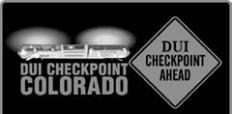
Publicizing sobriety checkpoints can aid in convincing drivers that their risk of being stopped and arrested has increased. State of Colorado Department of Transportation
8.Training police officers to detect impaired drivers. Specialized training—including understanding the physical and verbal cues that indicate alcohol impairment§—can help improve the ability of police officers to detect drunk drivers. The Standardized Field Sobriety Test (SFST) appears to be the most accurate of the tools that have been developed to assist police in recognizing indications of alcohol impairment. Endorsed by the U.S. National Highway Traffic Safety Administration, the SFST includes a horizontal gaze nystagmus test, a walk-and-turn test, and a one-leg stand test. A combination of tests is usually called for, because some drinkers, particularly serious alcoholics, can perform certain tasks even while profoundly impaired.§§
§ See National Highway Traffic Safety Administration (1997) [PDF] for detailed information about known cues for detecting drunk driving among truck and car drivers and National Highway Traffic Safety Administration (1993) [PDF] for information regarding motorcycle riders.
§§ Police officers can also receive training through the Drug Evaluation and Classification Program, a protocol that enables officers to rule out certain medical factors and establish probable cause that drivers are under the influence of drugs other than alcohol (American Prosecutors Research Institute, 2004; National Highway Traffic Safety Administration, n.d.; [PDF] http://www.theiacp.org/div_sec_com/committees/HighwaySafteyDeskTop.pdf International Association of Chiefs of Police, 2004 [PDF]).
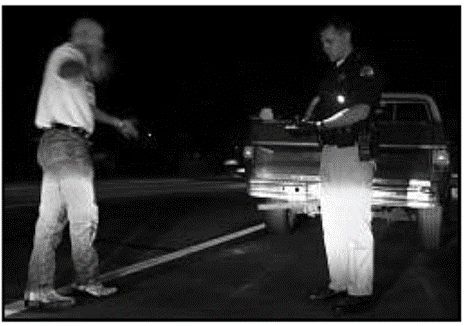
Training officers to recognize the physical and verbal signs of intoxication is critical for detecting drunk drivers. Credit: Deseret News
9.Using preliminary breath testing devices. Preliminary breath testing devices (PBT) are typically small and easy to operate. Some devices are passive sensors that can detect the presence of alcohol from within a few inches of a driver's face. Passive devices ordinarily do not require an officer to meet any evidentiary standard over and above the one required to stop the vehicle in the first instance. Other devices, which require a driver to blow into a tube or other aperture, ordinarily do require that the officer first have reason to believe that the driver has been drinking. Both types of devices aid officers in the field in determining that there is probable cause to believe that a driver is alcohol-impaired, usually with the net effect of increasing the likelihood of arrest. There is some evidence that jurisdictions that use PBT have lower alcohol-related fatality rates than those that do not. 54
Random breath-testing—whereby police have the legal authority to stop and demand an alcohol breath test from any driver at any time—has been demonstrated to be particularly effective,55 but is impermissible in the United States as a constitutional matter.
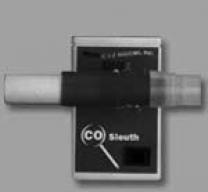
Police use of preliminary breath-testing devices such as the one pictured above increase the probability that a suspected drunk driver will be arrested. Breathe E-Z System, Inc.
Curtailing Driving Privileges
10.Suspending or revoking driver licenses administratively. Suspending or revoking the licenses of those convicted of drunk driving is one of the most effective methods for reducing alcohol-related crashes, but its effectiveness is limited by the capacity of police and others to enforce the conditions of suspension and revocation; moreover, this method is only effective, if at all, during the period of suspension or revocation.56 Administrative license suspensions—suspensions imposed by a licensing agency rather than by the courts—have proven more effective than judicial sanctions in some U.S. states, but not others.57
By some estimates, over three-fourths of drivers with suspended or revoked licenses continue to drive nonetheless.58 In fact, many drivers with suspended or revoked licenses never even bother to apply for license reinstatement when they are eligible to do so. One of the unintended consequences of mandatory license suspension and revocation laws is that judicial and law enforcement resources are consumed dealing with those who continue to drive under suspension or revocation.59
11. Imposing graduated licensing systems for young drivers. Several U.S. states have enacted so-called graduated licensing for young drivers. Typically, these systems grant young drivers limited privileges in their early driving years, such as restricting the number of passengers, the hours of operation, the use of cell phones while driving, or the types of vehicles that may be driven. These systems have been shown to have a positive effect on young drivers' attitudes about drinking and driving, on their willingness to either drink and drive themselves or ride in vehicles with drinking drivers, and on reducing their involvement in fatal and injury crashes.60
12. Impounding, immobilizing, or confiscating the vehicles of drunk drivers. Impounding the vehicles of drivers whose licenses have been suspended or revoked—for whatever reason, including drunk driving—is effective in reducing the likelihood that a driver will be charged with driving offenses, including drunk driving, or will be involved in a traffic crash.61 However, the mere threat of impoundment does not deter driving after suspension or revocation: a vehicle must actually be impounded to influence a driver's behavior.62 In some jurisdictions, police return the vehicle to its owner if the offender satisfactorily completes an alcohol treatment program and reimburses the government for the costs associated with impoundment.63 Impoundment or forfeiture is often complicated by the fact that the vehicle used by a habitual drunk driver is owned by someone else or that other members of the drunk driver's family might be inconvenienced by the loss of the vehicle.
An alternative to impoundment is temporary immobilization by the use of a device that either prevents the motor from operating or locks the vehicle's wheels.
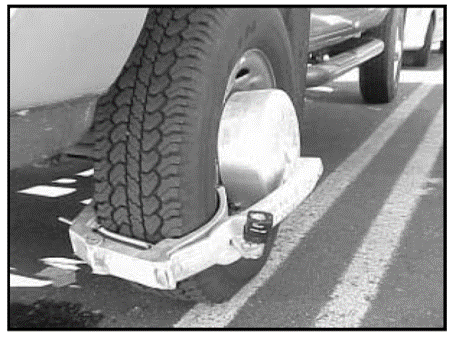
Devices such as the “boot” shown above can be used to temporarily immobilize a drunk driver’s vehicle. http://www.expo1000.com/parking/Interviews/superboot.jpg
In some jurisdictions, police and prosecutors apply for judicial forfeiture of the vehicle, thereby permanently depriving the offender of its use. There is some evidence that impoundment and immobilization are as effective as forfeiture as well as less costly and time-consuming for enforcement officials.64
In spite of the availability and apparent effectiveness of these responses, they are often not employed by police and prosecutors.65
13. Confiscating license plates from convicted drunk drivers. Confiscating the license plates of convicted drunk drivers is an effective way to discourage them from further drunk driving because it raises the probability that they will be stopped by police.66 Confiscation is a judicial sanction in some U.S. states and an administrative one in others. There is some evidence that confiscation of license plates would be more effective if it were more widely used and more widely publicized.67 Alternatively, some jurisdictions require convicted drunk drivers to display specially-marked license plates on their vehicles.68

In some states, special license plates are issued to convicted drunk drivers to discourage them from driving. Credit: Michael Scott
Sanctioning Convicted Drunk Drivers
There is an obvious case to be made for tailoring the sanctions imposed upon a convicted drunk driver to the likelihood that he will repeat the offense in the future. The challenge for the courts is to determine which offenders are likely to become repeat drunk drivers. Many courts require even first-time offenders to undergo alcohol assessments to determine whether they are social or problem drinkers. There is evidence that high blood alcohol concentration and a prior history of drunk driving or other traffic violations are significant predictors that an offender is likely to drink and drive again.69 In jurisdictions where they are in use, the data from alcohol ignition interlocks (see Response 14 below) can be useful in predicting who is likely to continue drinking and driving.70
14.Requiring convicted drunk drivers to install electronic ignition locks on their vehicles. Electronic ignition locks ("interlocks") have been shown to be effective in reducing the likelihood that a convicted drunk driver will be rearrested for drunk driving, at least while the ignition lock requirement remains in effect.71, § However, the deterrent effect does not necessarily last once the requirement is lifted.72 Drivers ordered to use ignition locks are commonly charged for their installation and maintenance. Where interlocks are optional, any alternative sanction should be sufficiently harsh to motivate the offender to use the interlock.73 Where the device requires a driver to periodically retest in order to keep the engine running, an offender is less likely to enlist a sober person to start the vehicle. One of the advantages of interlocks over license revocation and vehicle confiscation is that it allows the offender and his family to continue to use the vehicle for legitimate purposes such as employment. Obviously, this response will not be effective where a convicted driver has access to other vehicles that are not equipped with interlocks.
§ Ignition interlock devices require the driver to blow into a device that is connected to the vehicle's ignition.If the driver's blood alcohol concentration is above a set point, usually around .02, the vehicle will not start.
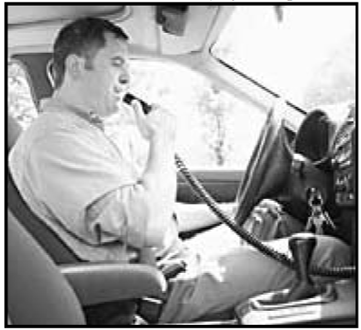
Ignition interlock devices require the driver to periodically retest to keep the engine running and have been shown to reduce the likelihood that a convicted drunk driver will be rearrested. Credit: Ontario Ministry of Transportation
15. Requiring convicted drunk drivers to complete alcohol assessment, counseling, or treatment programs. There is some evidence that successful completion of mandatory alcohol assessment and treatment programs can reduce the likelihood that those with clinically diagnosed alcohol problems will be rearrested for drunk driving.74 Depending on the quality of the program, the incidence of repeat drunk driving and alcohol-related crashes can be reduced by as much as 5 to 10 percent.75 There is some hope that new pharmaceutical treatments for alcoholism may also help reduce drunk driving by hard-core drunk drivers; as of yet, however, such treatments have not been widely tested.76
16.Confining convicted drunk drivers to their homes. In lieu of incarceration, some jurisdictions sentence convicted drunk drivers to home confinement. Compliance is typically monitored electronically. There is conflicting evidence regarding the effectiveness of home confinement.77
Monitoring Drunk Drivers
17. Closely monitoring high-risk drunk drivers. Closely monitoring drivers who have demonstrated that they are at high risk for driving while impaired has the potential to reduce the likelihood that they will be involved in alcohol-related traffic crashes.78 Such monitoring can be done by police, corrections officials, or treatment providers.
However, at least one intensive supervision program—a day treatment center that provided supervision, reporting, employment, counseling, education, and community resource referrals in a nonresidential facility—did not prove to be any more effective at reducing repeat offending than did a standard probation program.79
Reducing Alcohol Consumption
18. Reducing the consumption of alcohol. Reducing the total volume of alcohol consumed in a community can have a number of positive effects on public safety, including a reduction in drunk driving.§ This is especially true when young drivers are denied alcohol.80, §§ Alcohol consumption can be reduced in a variety of ways, including:
- Increasing the price of alcohol by raising taxes or prohibiting discount sales81
- Restricting the number of bars and liquor stores§§§
- Strict enforcement of the drinking age
- Regulating drink specials
- Raising public awareness through educational campaigns.
§ See the POP Guides on Assaults in and Around Bars and Underage Drinking for further information about ways to reduce alcohol consumption.
§§ See the POP Guide on Underage Drinking for further guidance on controlling minors access to alcohol.
§§§ However, too few sales outlets may result in drinkers driving farther to get alcohol, thereby increasing the risk they will be involved in alcohol-related crashes.
19. Suing alcohol beverage servers for serving intoxicated patrons who then drive and cause traffic injuries. Lawsuits brought against persons and establishments that serve alcohol to patrons who then drive while intoxicated and cause injury (so-called dram shop liability) can potentially discourage overserving patrons, thereby reducing drunk driving.82 However, the effectiveness of this response is limited because such suits are relatively rare, some jurisdictions protect licensed servers from such liability, and liability awards are often paid by insurance companies rather than by the offender directly.83 Liability insurers sometimes offer lower premiums to establishments that adopt responsible service practices, but some owners choose not to purchase liability insurance and either close their businesses or declare bankruptcy when they are sued.84
Suits against private individuals are even more rare and difficult to win than suits against business owners.85 For a variety of reasons, both licensed servers and private hosts are reluctant to intervene in the drinking habits of their guests and patrons.
20. Training alcohol beverage servers to recognize signs of impairment and enforcing laws prohibiting serving impaired patrons. Beverage server training programs have shown some positive effects in reducing alcohol-related traffic crashes in the jurisdictions where they have been adopted, but mandatory programs do not appear to be any more effective than do optional ones.86, § Servers learn how to promote eating, to slow drinking, to call for alternative transportation, to stop serving, and to have drinkers wait before driving. Sufficiently strict enforcement of laws prohibiting serving intoxicated patrons is essential in motivating servers to heed the advice of these programs; otherwise, the pressure to continue serving intoxicated patrons can be too great for many servers to resist. One of the dilemmas of mandatory training is that in jurisdictions where successful completion of a training program confers immunity on a server, its net effect may be to shield servers from dram shop liability without substantially reducing the likelihood that intoxicated patrons will be served.87 On balance, however, responsible beverage service training appears to be a good idea.88
§ The states of Oregon and Wisconsin mandate such server training.
21.Enforcing laws prohibiting serving minors and intoxicated persons. Enforcement of laws that are designed to prohibit serving minors and intoxicated persons in licensed establishments can help control a range of alcohol-related problems, including drunk driving.89 Enforcement efforts should be targeted at establishments where a high proportion of drunk drivers were last drinking.90 Unfortunately, such enforcement is rare in most jurisdictions, especially as it relates to serving intoxicated persons. This may be because police and other enforcement agents feel that they lack the resources to devote to this activity, perceive that provable cases are difficult to make, or are reluctant to face resistance from the restaurant and tavern industry.91
Public Education
22.Discouraging drinking and driving through public education and awareness campaigns. It is difficult to change public attitudes and behaviors with respect to drinking and driving through public education campaigns, at least in the short-term.† This is especially true among those at highest risk for drunk driving. Nonetheless, such programs can help build public support for addressing the problem and can help publicize changes in drunk driving laws.92 When they are used, public education and awareness campaigns to discourage drinking and driving should be tailored to particular segments of the population.93 Although young drivers are especially difficult to persuade, such campaigns are more likely to be effective if they exploit the influence of peers on the behavior of young drivers and emphasize the negative social consequences of drinking and driving rather than the health and legal risks.94 Programs that seek to correct young people's misperceptions about how much their peers drink (so-called social norming) hold promise for reducing alcohol consumption.§ Messages that focus on alternate forms of transportation, knowing when one has reached the point of intoxication,§§ helping out friends who are too drunk to drive, and the provisions and enforcement of new drunk driving laws are most likely to be effective.95 Teaching young people how to keep their peers from driving while intoxicated is effective,96 as are school-based programs intended to discourage students from riding with drunk drivers.97 Young people are more willing to intervene effectively to prevent their peers from driving while intoxicated than are adults. The use of celebrities and appeals to fear and emotion are not particularly effective among young people.98
† See Response Guide No. 5, Crime Prevention Publicity Campaigns for further information.
§ See the POP Guide on Underage Drinking for further information on reducing young people's alcohol consumption.
§§ The Wichita, Kansas, Police Department (1998) [PDF] offered free alcohol breath tests to drinking patrons at bars, clubs, concerts, and festivals as part of an effort to teach young drinkers to recognize when their intoxication was approaching the level at which it was unlawful for them to drive.
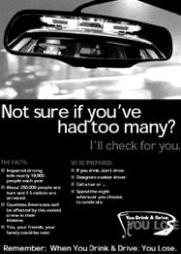
While it is difficult to change public behaviors with respect to drinking and driving, publicity campaigns can help build support within the community for addressing the problem. University of Oklahoma Police Department
Alternative Transportation
23. Providing alternative transportation options to drinking drivers. Alternative transportation options include designated drivers and free taxi or limousine rides. There is evidence that drinking drivers, even heavy drinkers, will use alternative transportation if it is made readily available.99 There is also evidence that alternative transportation programs can significantly reduce the incidence of drunk driving and alcohol-related traffic crashes and injuries.100 Such programs are most successful when drivers are not forced to leave their vehicles at the drinking location: the best programs take the drinker to the drinking location and then return him to his home.§
§ A pilot program in Wisconsin used business marketing principles to develop and promote taxi and limousine transportation to, from, and between bars in a rural community. Rather than trying to discourage drinking, the initiative acknowledged the local bar culture and sought to address patrons' specific reasons for driving after drinking (Karsten and Rothschild, 2003) [PDF]. An initiative in Wisconsin known as SafeRide that provides funding assistance to taverns to promote alternative transportation for patrons is partially funded by a surcharge on drunk driving convictions. An evaluation of the initiative concluded that it is cost-effective (Wisconsin Department of Transportation, 2005) [PDF].
Designated driving is now a well-established method for avoiding drunk driving, particularly among U.S. college students.101 However, there are any number of ways in which designated driving plans can go awry: the designated driver can change his mind and drink; the vehicle owner can change his mind and refuse to allow the sober person to drive; the drinkers in the group can drink more heavily than they would otherwise, which in turn can cause other problems.102 To date, there is insufficient evidence of the effectiveness of designated driver campaigns, either those directed at the general population or those targeting patrons of particular drinking establishments.103 However, designated driving appears to be a good idea that should continue to be promoted even if it is not as effective as was originally hoped.
Environmental Design
24. Locating licensed establishments in areas that reduce the need for patrons to drive. Limiting the number of licensed establishments that are only accessible by car seemingly has the potential to reduce drunk driving; however, the effectiveness of this response has not been properly evaluated.104 Obviously, there are practical limits as well, especially in rural areas. There are, however, strong arguments in favor of distributing licensed establishments throughout a community and sufficiently close to residential areas so that at least some patrons can walk—or at least not drive far—to these establishments.
25. Relaxing or staggering mandatory bar closing times. As may also be the case with other alcohol-related problems, relaxing or staggering mandatory closing times has the potential to lower the concentration of impaired drivers on the roads immediately after all the bars close. However, whether the net effect of this measure would be to increase overall alcohol consumption or to encourage drinkers to drive in search of a bar with a later closing time has not been studied.
Responses With Limited Effectiveness
26. Increasing the severity of penalties for drunk driving. By itself, increasing the severity of penalties for drunk driving does not appear to have a significant deterrent effect.105 This is so for several reasons:
- Most drunk drivers do not believe they are likely to get caught on any particular trip, so they tend not to take the severity of the punishment into account.
- If police officers believe that the potential punishment is unduly harsh, they may be less likely to arrest drunk drivers. So too with judges and jurors, who may be less likely to convict or impose stiff penalties.
- Incarcerating more drunk drivers or incarcerating them for longer periods can so overburden existing jail resources that police are forced to curtail drunk driving enforcement.106
27. Incarcerating convicted drunk drivers. Although the general public is likely to insist upon punishing drunk drivers—particularly repeat offenders—research suggests that conventional punishments such as fines and incarceration are among the least effective methods of controlling drunk driving.107 In addition, using jail resources for drunk drivers becomes more difficult to justify as those resources become scarce. The threat of incarceration, however, is often useful as leverage to compel convicted drunk drivers to accept alternate sanctions such as alcohol treatment, alcohol ignition interlocks, or vehicle forfeiture.
Even where jail time is required by law, many offenders do not actually spend the mandatory minimum time in jail. There are a variety of ways around mandatory minimums: for example, some offenders are credited with having served a full day in jail even if they are only incarcerated for a few hours. Moreover, mandatory minimum jail sentences raise the stakes of drunk driving convictions, which in turn leads to more vigorous legal defenses, delays in case processing, fewer guilty pleas, jail and court crowding, and so forth, all of which creates a counter-pressure to process drunk driving cases more quickly.108
28. Fining convicted drunk drivers. Fining convicted drunk drivers has not shown any significant deterrent effect, either on the offender or the general public.109 There is typically a high rate of failure to pay fines by convicted offenders. The primary purpose of fines is to offset the cost of enforcing drunk driving laws and of processing cases.
29. Recovering costs from drunk drivers. Some jurisdictions allow the police to recover the costs of processing drunk driving arrests.110 Although the effectiveness of this response has not been adequately evaluated, there is little reason to believe that it has any greater deterrent effect than does the imposition of fines. It does have the advantage, however, of channeling revenue back to police, which should reinforce enforcement efforts.
30. Requiring drunk drivers to listen to victim impact panels. Victim impact panels force convicted drunk drivers to listen to testimony—from the victims of drunk driving, their family members, the police, and medical professionals—regarding the impact that drunk driving has on individuals and society. In spite of the powerful and immediate emotional impact of these panels, their effectiveness seems to be short-lived: the evidence is that they only prevent offenders from being rearrested in the short term, usually within two years.111 Moreover, their impact appears to depend heavily upon the particular testimony of the panelists, something that is difficult to standardize.112
31. Prohibiting drive-up alcohol sales. Although permitting drivers to purchase alcohol through drive-up windows appears to be a bad idea for a number of reasons, there is inconclusive evidence that the practice has any significant effect on alcohol-related crashes.113 This is probably because it is relatively easy to purchase alcohol—even if a driver has to step out of his vehicle to do so—as most convenience stores and many gas stations sell alcoholic beverages.
32.Providing driver education courses in high schools. One unfortunate effect of providing driver education courses in high schools is that it encourages more young drivers to get their licenses, which in turn leads to more young drivers getting in alcohol-related crashes.114 This is not to say that driver education courses do not have positive effects, but rather that their effectiveness in reducing drunk driving appears to be limited.
Free Bound Copies of the Problem Guides
You may order free bound copies in any of three ways:
Online: Department of Justice COPS Response Center
Email: askCopsRC@usdoj.gov
Phone: 800-421-6770 or 202-307-1480
Allow several days for delivery.
Email sent. Thank you.
Drunk Driving
Send an e-mail with a link to this guide.
* required
Error sending email. Please review your enteries below.
- To *
Separate multiple addresses with commas (,)
- Your Name *
- Your E-mail *
Copy me
- Note: (200 character limit; no HTML)
Please limit your note to 200 characters.
